Published Works
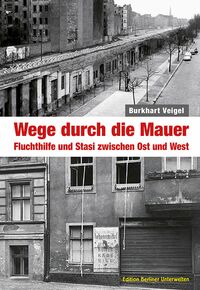
List of publications, except works on medicine:
- 2009
"Berlin, Gleimstraße", in: Ines Geipel, Andreas Petersen (Ed.): „Black Box DDR“, Marixverlag - 2010
Uwe Johnson: "Ich wollte keine Frage ausgelassen haben", Suhrkamp Verlag (Edited by Burkhart Veigel). - 2011
"Wege durch die Mauer – Fluchthilfe und Stasi zwischen Ost und West", Berliner Unterwelten e.V., Christoph Links Verlag GmbH; 4th Edition October 2015
3rd and 4th Edition
-
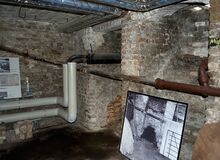
Heinz Jercha crawled through this tunnel being shot in the East by a Stasi murderer. He died shortly after arriving in the West. -
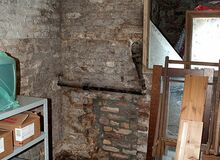
"Franzke Tunnel" seen from a different angle. (cf. the image in section "Escape Routes" – recognizable by the water pipe over the tunnel entrance). -
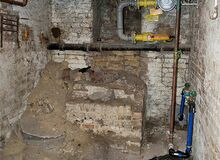
This tunnel (the "Arndt Tunnel") ran beneath the foundation of the house on Heidelberger Straße 36.
In the 3rd edition, photos of a modified Cadillac are shown for the first time: pictures of the hiding place under the dashboard with a person in the compartment, etc.; also 3 newly examined tunnels under Heidelberger Straße between Neukölln and Treptow (one of which in exactly the same condition as left behind 50 years ago).
I was able to add some details concerning Heinz Jercha's death. This edition is 64 pages longer than originally planned, because many new facts accured that should be included. You will discover many new facts, even if you know the existing edition.
In the 4th edition the tunnel in Kleinmachnow will be explained and informers will be named.
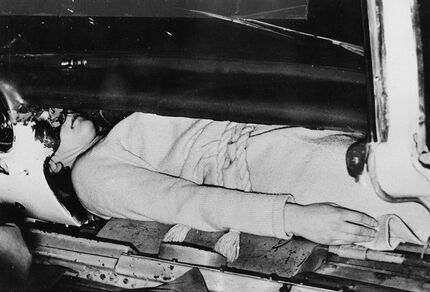
Addenda for the book „Wege durch die Mauer“
It took the Schulzes and the Liedtkes, two couples, 15 attempts to escape finally. This story is told here in detail, as in the book it is given only in short for reasons of space. This amplification fits into page 131 of the 3rd and 4th editions. I admire these couples' energy and persistence, who did everything to flee their homeland and its regime.
Exactly on the weekend of this sailing trip, the border was "sealed!" All plans for the future were endangered. Hans and Gerda sent the brother home and began their search for an escape route on August 13th on the border in the north of Berlin; specifically near Lübars (1). They knew the area well, owing to many walks they had taken there. However, they found no way through; solely barbed wire bales everywhere, heavily armed guards and dogs.
As many other refugees did they rode up and down on the metro-train from Schönhauser Allee to Pankow – a long stretch along the border – thinking they might be able to jump from the car at one of the curves facing the West, where the trains had to slow down (2); but the train travelled too fast to risk that. Aside from this, nobody knew the exact position of the border. Did the railway embankment and the second track belong to the East, or would one at least be in the West after lying on the ground, injured from the jump?
The entire embankment, which had played a role in escapes through the Esplanade-channel was in East territory and was strewn with bales of barbed wire. The very next day this train route was discontinued – perhaps because somebody had jumped off there.
The next idea they had was to flee through the Panke River (3) in Bürgerpark, which flowed under a metro rail bridge into the West. That would have been quite simple. However, because of the easy access, Vopos (abr. "Volkspolizei" = "People's Police") with their dogs patrolled through the park along the border day and night; so there was no way out either.
Finally, they rode to S-Bahn station Friedrichstraße. East-Berliners were not allowed entrance to the platform heading to West Berlin. They could only step onto the other platform, the starting point for eastern directions. Standing on the aisle inside their train there, they were directly opposite the West-train. Somebody could open the "wrong" doors and they'd be able to hop over onto the West-train; or so they thought (4); but without a helper to open the opposite door, this was not possible.
A few such escapes had actually been successful, which is why a wall was erected between both platforms on August 14, 1961.
After the frustrating experiences of this day, they rode home – exhausted and depressed. They did accomplish one thing, however: they sent a telegram to Gerda's cousin in West Berlin, asking him to visit her. Being with him the next evening, she wanted to give him passport photos to take to the West. Perhaps somebody there would be able to mount them onto a West Berliner ID-card. They thought, If her cousin could come across without problems, he could next time smuggle the false legitimation into the East and they could leave the DDR just as he did (5). But the cousin, a city councilman in West Berlin, wanted to inquire first whether that was permissible. He could not be dissuaded from the premise that one could only forge an ID if it had belonged to a recently deceased person; so they had to discard this idea as well.
On Monday, August 14th, the Liedtkes went to work as usual. In the evening, after the righteous cousin had left, they noticed that the window in the apartment of the Schulz family was open. They had broken off their vacation and returned to East Berlin as soon as they had learned that the border had been closed. The Schulzes, for their part, were surprised to see the Liedtkes there, assuming them to be already in the West after their security overnight stay in West Berlin.
Now the four of them began to plan together how and when they might flee. September 17th, 1961 was the local Election Day. Whoever did not go to the polls voluntarily would usually be picked up at home by members of the FDJ or the Communist Party. Gerda's mother, however, had gone to West Berlin on September 11th. If anyone had come looking for her in order to escort her to the polls – or in a month, at the very latest – they would have noticed that she had left; and that the Liedtkes had not reported it. Therefore they had to act quickly.
That very night the Liedtkes went to scout the area north of Charité Hospital (6). They crept behind the Naturkundemuseum (Museum of Natural Science) and crawled by the light coming from the policlinic (today known as the Bundeswehrkrankenhaus [Military Hospital]) past a sports field (today the Bundesnachrichtentdienst Zentrale [Federal Intelligence Service Headquarters] stands here) to a large and partly overgrown canal with a small brook which had been branched off from the Panke in the West. Maybe it was possible to crawl through to the West along the bottom of the canal ditch.
The Panke river
The "brook" was the southern Stadtpanke, actually the former Panke River. Nowadays it is drained. Only its estuary to the Spree River near Schiffbauer Damm can still be seen clearly. Its entire body of water is led through Schönhauser Graben (Schönhauser ditch), an artificial canal of considerable size what is called the "Panke" today. The dried river bed, the surviving remnant of the natural Panke River, crossed the border under checkpoint Chauseestraße.
Gerda hid in the bushes, while Hans progressed slowly towards the West in the direction of the urban district Wedding. After he had arrived approximately halfway between the sports field and the illuminated border, he reached a conduit that carried water of the brook. As he didn't want to crawl any further without a flashlight, he turned. But he slipped and cut his hand severely with a fragment. Reaching his wife, they decided to give up for that moment, return home as quickly as possible, change clothes, and go to an emergency clinic that same night.
The wound was heavily soiled and became infected, so that his hand became seriously swollen. The doctor in charge certified him unfit for work. The heavy bandage and the pain hindered him, but having been reported as ill, he had the entire next day to look for another way to escape. By daylight, the spot he had reached the night before turned out to be still too far away from the border. He doubted that the four of them could make it safely through such a long tube, what meant, no further attempt from that spot.
That was a good decision, because the conduit did not cross the border completely, but rather ended just a bit further than he had gone before and led into another ditch – 40 meters long – which in turn led to a different conduit reaching the West. If a refugee were to come this far, he would no doubt be spotted at the open ditch by border guards. No refugee was able to reach the long conduit leading across the border.
When Hans went to his workplace to show his bandaged hand, a colleague commented, "Did you grab some barbed wire?" without drawing any further conclusions. When Hans returned home and related this to his wife and their friends, they decided it would be best not to do anything which might arouse suspicions for a few days.
The next idea was to climb the wall at Charité Hospital and swim through the Humboldt-harbor (7). They had already made rope ladders in order to scale the wall. But then they heard on the Western news broadcast that a refugee had been shot to death at the Humboldt-harbor. They didn't want to risk being killed by gunfire, or to drown in the harbor after being wounded, so they abandoned any plans for this route.
Günter Litfin
Günter Liftin was the first refugee to be shot at the border. When he tried to swim across Humboldt-Hafen into the West on August 24th, 1961, a "Trapo", a transport policeman, shot and killed him. He had live ammunition in contrast to the workers' militia, which were ordered to the border. They behaved like warlike border guards, but were only issued live ammunition following this murder.
That following Sunday, August 27th, 1961, the two men went to the North of Berlin once again, this time to Glienicke Nordbahn. Hans knew the way to Lübars and Hermdorf in the West from earlier days. He also knew that no posts could be erected – and therefore no fences built – on the swamp like grounds there (8). During daytime they were able to see from a distance that there seemed to be no fence, no designated border, nor a control point. As they crawled closer at dusk, they spotted with their binoculars quite a number of patrolling Vopos, some even with dogs. The thought of being pursued together with their wives by dogs, even though there was no fence, frightened them, so they decided to look for a better possibility.
This is the area where Joachim Rudolph ("der Kleene" = "The Shorty") and Manfred Krebs ("der Lange" = "The Tall") fled from Schildow to Lübars in spite of the later constructed watchtower, border guards and dogs. Thereafter they became escape helpers, first Joachim, then Manfred, both specializing in tunnel digging.
At their next meeting they conjectured whether they would be able to flee across one of the sewage canals between the East and the West of Berlin. But how could they determine which conduits were large enough to permit movement through them? And which ones ran from East to West? Which one could they enter undetected? They were not familiar with the Berlin sewage system, but the line of manhole covers north of Pankow public swimming pool on the street "Am Schlosspark" led to the border. So they decided to enter the sewage canal there – although the entrance was still a long distance away from the border. But at least they could enter there without being seen. Then they would have to crawl through the sewage conduit for several hours before reaching the 'West.
After having orientated themselves in general by daylight, all four of them set off in early September with flashlights, city map and compass (9). They had taken their subtenant, Klaus Müller, a dentistry student, into their confidence about the plan and asked him to close the manhole cover after they would have entered. The canal was so small, that they were forced to crawl. So they turned in order to acquire knee protectors for the next night. Hans also wanted to get some plastic bags to be able to keep the bandage on his hand dry.
Klaus Müller and his escape
Kaus Müller, the subtenant, wanted to absolve his pre-med exam before his intended escape from the GDR. After he had passed the task in February of 1962, he planned his escape together with his mother and brother, who lived in West Berlin. Being a strong swimmer, he wanted to swim underwater into West Berlin. He had heard that the border patrol could locate escapees by their air bubbles coming to the surface and then were able to stab the people underwater with long, pointed poles. Due to this, he descided to use a closed circuit underwater breathing apparatus, which left no trail of bubblesl.
This equipment though was on the Stasi list of banned objects. In other words, it was impossible to purchase such an apparatus – not even parts of one in the East. His mother and his brother, therefore, brought over the equipment piece by piece from West Berlin. They had painted the oxygen tanks red and claimed that these were fire extinguishers for the car. These had to be replaced several times, because Klaus used the oxygen up practicing in the Brandenburg lakes.
Realizing that he couldn't reach any water way which exited into the West, he concocted a daring plan: In the Fall of 1962 he entered the Panke River at night near Reinhardstraße – where there was a conduit system – and let himself be carried by the current into the Spree River. He knew this would work, because he had tried it with several pieces of wood. At the opening under Schiffbauer Damm he dived into the Spree. Nobody had observed this. However, when he surfaced briefly for orientation, border guards saw him and started to shoot. He didn’t notice that, because he had dived back beneath the surface almost immediately, continuing along the entire length of the Spree and finally re-surfacing in the West near Kronprinzenufer (today called the Ludwig-Erhard-Ufer), where he climbed onto land. Only there he learned from Western police that border guards had shot at him. Later nets were stretched across the Spree River in this area to hinder further escapes of this kind.
The next day, the four friends wanted to progress further into the conduit. It hadn't rained, so the canal was as dry as it had been the previous night. They bade the dental student farewell, promised to carry his greetings to his family in West Berlin - and crawled off. But the canal grew smaller and smaller and they soon noticed that it didn't lead straight toward Wollankstraße and freedom as they had thought, but rather turned to the south beneath Kavalierstraße. When the sounds they heard from above led them to believe that they must now be near the Pankow train station, they gave up. However, even turning around in the narrow canal proved to be nearly impossible, particularly for Waltraud Schulze, beeing somewhat heavy. Finally, when they arrived at the street drain where they had entered, they found that they couldn't get out without help from outside.
To be trapped in a tight tube 2 meters under ground was the ultimate low of all their optimistic attempts to flee! Should they knock on the manhole cover to attract attention? That would have been the most certain way to land in prison. They were close to panicking.
They crawled further toward the next drainage entrances and tried to remove the covers at each one, but failed. The conduit now led north. This gave them hope, for the Panke River had to be somewhere along there. Perhaps they could exit there without having to remove any cover at all. The tube did, in fact, open on to the Panke River next to a small bridge for pedestrians..
But even there they couldn't simply climb out. The entrance and the entire area were brightly illuminated. They immediately understood why: Having reached Schlosspark Niederschönhausen, the fugitives had crawled almost under the palace in which the State President resided. So they slid directly into the Panke and crawled slowly – so as not to make any noise – toward the East. Only after another 300 meters they climbed out onto the street.
The following nights they entered the canalization system three times via Panke River near Grabbealle in Bürgerpark (citizens' park) (10). Finding that this canal also did not lead to the West, they decided to try their luck in the south of East Berlin. To make manhole cover lifting easier, they forged an iron jack in their burner (!) at home (They had to avoid any smoke, as nobody uses his heater in the middle of summer!). Gerda Liedtke had to go to work every morning, so the men wanted to make the next trial runs by themselves.
Waltraud and Ulrich Schulze had no jobs and Hans Liedtke was on sick leave.
In Treptow, on Baumschulenweg, they had to give up because there was no ventilation in the canalization system there and the sewage gas made breathing impossible (11). On Kiefholzstraße they had to turn back without entering the canal due to the complexity of the area (12), and on Heidelberger Straße (13) they had a very unpleasant encounter:
Here, the houses were built so close to each other, that there was no chance of entering without being seen. When – in spite of that fact – they opened a drain cover in the middle of the night to at least see if the canal was spacious enough, a man crossed the street and went directly past them. He simply walked on expressionlessly. Either he didn't want to see anything, or perhaps thought that work was being done on the system during the night. Ulrich and Hans were paralyzed. They whispered to each other: "If he had tried to challenge us, would you have …?" "Yes, I would have hit him, in order to get away." "And if he got killed?" "Well …" Luckily nothing happened!
Caused by the long and nerve-wracking search for an escape route, after so many failed attempts, the four friends became less and less choosy concerning their method of escape, and at the same time more and more aggressive toward this State and its representative authorities who held them captive.
They also failed with their attempts to get into one of the three different conduits off the Spree River, from the southern bend (14), because – to let the subway cross above – every one of them was equipped with an inverted drainage siphon in which the water reached the ceiling. Each time Ulrich Schulze dived in, he had to turn after only a short stretch, due to the fact that he found no air ducts leading to the surface.
On occasion of their forays in the Spittelmarkt area they had seen the large rubble fields south of the subway tracks, remnants of WW II. If they could find a sewage canal here, at least they could enter in this godforsaken place without being seen. Furthermore, a sewage canal from here would surely lead into the West – in connection with either the Spree River in the East or the Landwehr Canal in the West. Those possibilities seemed to be good prospects and their hopes of escaping rose again on the night of September 11th, 1961. For that reason, their wives came along this time (15).
Opening the working escape route
The rest of this escape marathon is recorded in my book. With their successful escape, these two couples opened a new escape route for about 500 refugees.
Reviews
Reviews of the book “Wege durch die Mauer – Fluchthilfe und Stasi zwischen Ost und West" ("Ways through the Wall – Aided Escape and Stasi between East and West")
"Escape aid is a conglomerate: one can be active as a tunnel digger, a passport forger, tightrope walker, or diver. Veigel, who surveys the entire illustrious panorama of these "dark arts", lets the reader take part in them all. Veigel and his fellow students from the Free University, Berlin had thought so deeply about the psychology (and pathological psychology) of the GDR border guard, that they could easily have earned PhD's in the field of "operative psychology". This subject really was taught at a secret Stasi operated college. The author kept accurate accounts of expenditure, income, code words, data … That makes the book not only entertaining, but above all, a dependable source of information. Not only is a Stasi agent mentioned by name, but the refugee as well – by their real names. No blurring of facts here! The GDR held "championship status" in fighting against its fleeing citizens. The GDR Minister of Justice, Hilde Benjamn (also known as "Red Hilde") thought of a means of capital punishment especially for Burkhard Veigel as early as 1962. His efforts were responsible for 650 successful escapes. Her pronouncement was trial, condemnation, and execution to be carried out by an "unsuspected gunshot into the back of the head at close range." But even "Red Hilde" could not execute someone whom she did not have in her clutches. Veigel is still very much alive, but Hilde Benjamin is dead."
Hans Halter, Süddeutsche Zeitung October 10, 2011
"Burkhart Veigel smuggled hundreds of GDR citizens across the best protected border in the world: behind the dashboard of a Cadillac, through tunnels and with false identification – directly under the border guards' noses. The Stasi tried to abduct him; the GDR Minister of Justice wanted him dead. His is the story of a medical student from southern Germany who became one of the most successful escape helpers between Germany and Germany. Had it not been for his hard-nosed conscientiousness, he would never have been able to pull the wool over the eyes of the gigantic GDR security system and the State Security (Stasi) agency hundreds of times. Veigel is not the type of person to pat himself on the back: "I wanted to help people; I felt it was my duty to do so. When your life is in constant danger, you get used to it." Burkhart Veigel has written the history of aided escape."
t-online.de, August 12, 2011
"The insanity of Germany's division was mirrored in the artful tricks escape helpers employed. Burkhart Veigel was one of them. His book describes the escape routes across the wall with suspense, as well as with facts. The Stasi informers and pursuers threatened his life constantly. He resisted two attempts to abduct him and defeated the Stasi in his own way: through humanitarian help for the captive population of the GDR. This book is an absolute must for everyone who experienced those times, but also for younger readers …!"
Petra Bohm by Orell Füssli, Switzerland, November 12, 2011.
"Burkhart Veigel has written a profound insider's view of aided escape."
Eberhard Diepgen in his honorific speech, July 18, 2011
"This form of opposition, although to present date hardly noticed, deserves the highest respect. Looking back, Burkhart Veigel can say: It was well worth it! What a tremendous feat this man has performed with such a prudence!"
Udo Scheer, Commune 6/11 and political opinion, December 2011